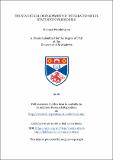Files in this item
The statistical development of integrated multi-state stopover models
Item metadata
| dc.contributor.advisor | King, Ruth | |
| dc.contributor.author | Worthington, Hannah | |
| dc.coverage.spatial | 282 | en_US |
| dc.date.accessioned | 2019-07-30T15:51:47Z | |
| dc.date.available | 2019-07-30T15:51:47Z | |
| dc.date.issued | 2016-06-24 | |
| dc.identifier.uri | https://hdl.handle.net/10023/18206 | |
| dc.description.abstract | This thesis focusses on the analysis of ecological capture-recapture data and the estimation of population parameters of interest. Many of the common models applied to such data, for example the Cormack-Jolly-Seber model, condition on the first capture of an individual or on the number of individuals encountered. A consequence of this conditioning is that it is not possible to estimate the total abundance directly. Stopover models remove the conditioning on first capture and instead explicitly model the arrival of individuals into the population. This permits the estimation of abundance through the likelihood along with other parameters such as capture and retention probabilities. We develop an integrated stopover model capable of analysing multiple years of data within a single likelihood and allowing parameters to be shared across years. We consider special cases of this model, writing the likelihood using sufficient statistics as well as utilising the hidden Markov model framework to allow for efficient evaluation of the likelihood. We further extend this model to an integrated multistate-stopover model which incorporates any available discrete state information. The new stopover models are applied to real ecological data sets. A cohort-dependent single-year stopover model is applied to data on grey seals, Halichoerus grypus, where the cohorts are determined by birth year. The integrated stopover model and integrated multi-state stopover model are used to analyse a data set on great crested newts, Triturus cristatus. A subset of this data is used to explore closed population models that permit capture probabilities to depend on discrete state information. The final section of this thesis considers a capture-recapture-recovery data set relating to Soay sheep, a breed of domestic sheep Ovis aries. These data contain individual time-varying continuous covariates and raise the issue of dealing with missing data. | en |
| dc.language.iso | en | en_US |
| dc.publisher | University of St Andrews | |
| dc.subject | Integrated stopover model | en |
| dc.subject | Capture-recapture | en |
| dc.subject | Hidden Markov model | en |
| dc.subject | Multi-state | en |
| dc.subject.lcc | QA276.8W7 | |
| dc.title | The statistical development of integrated multi-state stopover models | en_US |
| dc.type | Thesis | en_US |
| dc.contributor.sponsor | Carnegie Trust for the Universities of Scotland | en_US |
| dc.contributor.sponsor | National Centre for Statistical Ecology | en_US |
| dc.type.qualificationlevel | Doctoral | en_US |
| dc.type.qualificationname | PhD Doctor of Philosophy | en_US |
| dc.publisher.institution | The University of St Andrews | en_US |
| dc.identifier.doi | https://doi.org/10.17630/10023-18206 |
This item appears in the following Collection(s)
Items in the St Andrews Research Repository are protected by copyright, with all rights reserved, unless otherwise indicated.

